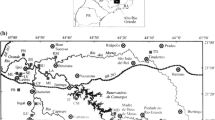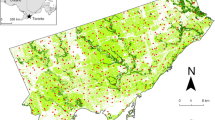Abstract
Suburban forest fragments often experience heavy recreational and waste disposal use, with considerable damage to the vegetation. To suggest strategies for conservation of the forest flora, spatial distributions of human impact were described in 40 fragmentary stands in northern New Castle County, Delaware. The distribution of human impact showed a significant bias to the forest edge, with 95% of localized damage occurring in the first 82 m. Forms of impact related to lawn maintenance fell significantly closer to the edge than impacts related to recreation and showed the strongest edge orientation. Edge distances of campsites, vandalized trees, and firewood gathering were negatively correlated with distance to the nearest graded road, indicating the importance of road access. Several forms of impact were also clustered near footpaths, although distance to paths was independent of edge distance in all cases. In terms of penetration of the forest and severity of damage, human impact greatly exceeds natural edge effects reported for this community. These findings suggest that damage may be minimized by limiting road access and avoiding the creation of small forest fragments.
Similar content being viewed by others
Literature Cited
Bratton, S. P., L. L. Stromberg, and M. E. Harmon. 1982. Firewood-gathering impacts in backcountry campsites in Great Smoky Mountains National Park. Environmental Management 6:63–71.
Cole, D. N. 1987. Research on soil and vegetation in wilderness: A state-of-knowledge review. Pages 135–177in R. C. Lucas (comp.), Proceedings, national wilderness research conference: Perspectives, state of knowledge, and future directions. USDA Forest Service General Technical Report INT-220. Intermountain Research Station, Ogden, Utah.
Cole, D. N., and J. L. Marion. 1988. Recreation impacts in some riparian forests of the eastern United States.Environmental Management 12:99–107.
Furuseth, O. J., and R. E. Altman. 1991. Who's on the greenway: Socioeconomic, demographic, and locational characteristics of greenway users.Environmental Management 15:329–336.
Garay, I., and L. Nataf. 1982. Microarthropods as indicators of human trampling in suburban forests. Pages 201–207in R. Bornkamm, J. A. Lee, and M. R. D. Seaward (eds.) Urban ecology. Blackwell, Oxford.
Gysel, L. W. 1951. Borders and openings of beech-maple woodlands in southern Michigan.Journal of Forestry 49:13–19.
Hall, C. N., and F. R. Kuss. 1989. Vegetation alteration along trails in Shenandoah National Park, Virginia.Biological Conservation 39:211–227.
Herzog, T. 1989. A cognitive analysis of preference for urban nature.Journal of Environmental Psychology 9:27–43.
Hinds, T. E. 1976. Aspen mortality in Rocky Mountain campgrounds. USDA Forest Service Research Paper RM-164, Rocky Mountain Forest and Range Experiment Station, Fort Collins, Colorado.
Hoehne, L. M. 1981. The ground layer vegetation of forest islands in an urban-suburban matrix. Pages 41–54in R. L. Burgess and D. M. Sharpe (eds.), Forest island dynamics in man-dominated landscapes. Springer-Verlag, New York.
Hull, R. B., and A. Harvey. 1989. Explaining the emotion people experience in suburban parks.Environment and Behavior 21:323–345.
Kuss, F. R. 1986. A review of major factors influencing plant responses to recreation impacts.Environmental Management 10:637–650.
Kuss, F. R., and C. N. Hall. 1991. Ground flora trampling studies: Five years after closure.Environmental Management 15:715–727.
Leonard, R. E., J. L. McMahon, and K. M. Kehoe. 1985. Hiker trampling impacts on eastern forests. USDA Forest Service Research Paper NE-555. Northeastern Forest Experiment Station, Radnor, Pennsylvania.
Loeb, R. E. 1989. The ecological history of an urban park.Journal of Forest History 33:134–143.
Martin, S. R., S. F. McCool, and R. C. Lucas. 1989. Wilderness campsite impacts: Do managers and visitors see them the same?Environmental Management 13:623–629.
Matlack, G. R. 1993a. Microclimate variation within and among deciduous forest edge sites.Biological Conservation (in press).
Matlack, G. R. 1993b. Vegetation dynamics of the forest edge: Trends in space and successional time.Journal of Ecology (in press).
Merriam, L. C., K. Groekermann, J. A. Bloemendal, and T. M. Costello. 1971. A progress report on the condition of newly established campsites on the Boundary Waters Canoe Area. Minnesota Forest Research Note 232.
Ranney, J. W., M. C. Bruner, and J. B. Levenson. 1981. The importance of edge in the structure and dynamics of forest stands. Pages 67–95in R. L. Burgess and D. M. Sharpe (eds.), Forest island dynamics in man-dominated landscapes. Springer-Verlag, New York.
Roggenbuck, J. W., and R. C. Lucas. 1987. Wilderness use and user characteristics: A state-of-knowledge review. Pages 204–205in R. C. Lucas (comp), Proceedings, national wilderness research conference: Perspectives, stage of knowledge, and future directions. USDA Forest Service General Technical Report INT-220. Intermountain Research Station, Ogden, Utah.
Stankey, G. H., and R. Schreyer. 1987. Attitudes toward wilderness and factors affecting visitor behavior: A state-of-knowledge review. Pages 246–293in R. C. Lucas (comp.), Proceedings, national wilderness research conference: Perspectives, state of knowledge, and future directions. USDA Forest Service General Technical Report INT-220. Intermountain Research Station, Ogden, Utah.
Wales, B. A. 1967. Climate, microclimate, and vegetation relationships on north and south forest boundaries in New Jersey.William L. Hutcheson Memorial Forest Bulletin (Rutgers University) 2:1–57.
Wales, B. A. 1972. Vegetation analysis of north and south edges in a mature oak-hickory forest.Ecological Monographs 42:451–471.
Author information
Authors and Affiliations
Rights and permissions
About this article
Cite this article
Matlack, G.R. Sociological edge effects: Spatial distribution of human impact in suburban forest fragments. Environmental Management 17, 829–835 (1993). https://doi.org/10.1007/BF02393903
Issue Date:
DOI: https://doi.org/10.1007/BF02393903




